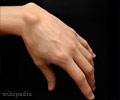The use of ultrasound for the quantitative characterization of the lung to predict the extent of pulmonary edema, has been identified.

- When ultrasound waves travel through the body some of each wave's energy is reflected as an echo which is monitored using an ultrasound scanner.
- When ultrasound waves hit the air pockets in the lungs, they scatter multiple times and the process of bouncing back to the scanner as an echo takes much longer.
- By observing the changes of the reflected echoes, the extent to which the space between the air pockets was filled with fluid, was calculated.
"Historically, it has been difficult to use ultrasound to collect quantitative information on the lung, because ultrasound waves don't travel through air- and the lung is full of air," says Marie Muller, an assistant professor of mechanical engineering at North Carolina State University and co-author of a paper on the work. "However, we've been able to use the reflective nature of air pockets in the lung to calculate the amount of fluid in the lung."
Why Lung Looks Like a Grey Blob Through Ultrasound Scanner
When ultrasound waves travel through the body, most of each wave's energy passes through the tissue. But some of that energy is reflected as an echo. The ultrasound scanner monitors these echoes and creates an image of the tissue that the waves passed through. This happens in microseconds.
But when ultrasound waves hit air, all of the energy is reflected, which is why ultrasound images of the lung tend to look like a big, grey blob, with little useful information for health-care providers.
Ultrasound waves scatter as they hit air pockets in the lung, or alveoli. When the scattered waves hit other air pockets, it scatters them further.
Technique Manipulated
All the ultrasound waves take different path by bouncing in different directions as they travel through the lung. So their echoes take different amounts of time to return to the scanner.
By looking at all of the echoes, and how those echoes change over time, Muller and her collaborators were able to calculate the extent to which the space between the air pockets was filled with fluid.
Two sets of experiments using rats and rat lung tissue were conducted to test their approach.
In the first set, researchers used rat lung tissue that had been injected with saline solution to mimic fluid-filled lung tissue. They were able to quantify the amount of fluid in the lung to within one milliliter, using the new approach.
In the second set, researchers found significant differences between fluid-filled and healthy lungs in rats. The researchers calculated the mean distance between two scattering events or how far an ultrasound wave traveled between two air pockets.
The mean distance in the fluid-filled lungs was 1,040 micrometers, whereas the mean distance in healthy lungs was only 332 micrometers.
"This is important, because one could potentially track this mean distance value as a way of determining how well pulmonary edema treatment is working," Muller says.
The technique makes use of conventional ultrasound scanning equipment, though the algorithm used by the researchers would need to be incorporated into the ultrasound software.
"Altogether, the cost would likely be comparable to existing ultrasound monitoring applications," Muller says.
The findings are published in the journal Ultrasound in Medicine & Biology.
Reference
- Kaustav Mohanty et al. Characterization of the lung parenchyma using ultrasound multiple scattering. Ultrasound in Medicine & Biology; (2017) doi.org/10.1016/j.ultrasmedbio.2017.01.011
Source-Medindia











